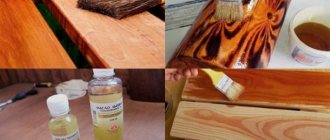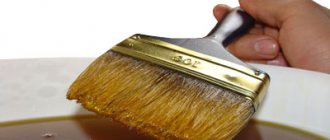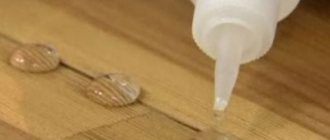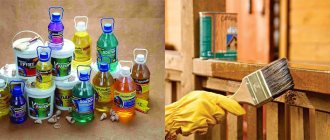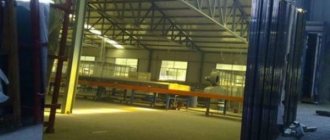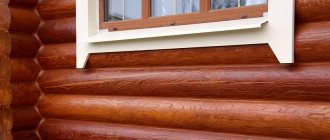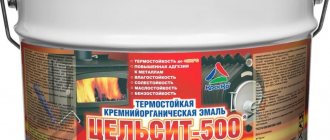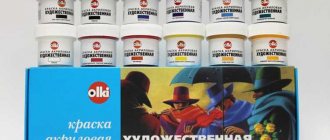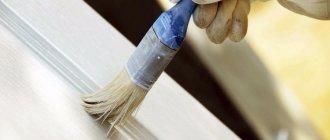Wood fire retardant efficiency groups
All compositions are divided into three groups of fire retardant effectiveness:
- First group (I).
You can get wood that is difficult to burn. In this case, there is a loss of no more than 9% of the mass of the prototype during combustion; - Second group (II).
You can get fire-resistant wood. In this case, the weight loss is 9-30%; - Third group (III).
In this case, high fire protection is not provided, and the weight loss of the prototype is more than 30%.
In other words, in order to get the greatest efficiency from the selected fire retardant composition, preference should be given to the option that belongs to the first group.
Solution price
The price range for foaming paint and varnish compositions is very wide - from 30 to 350 rubles / kg.
When choosing a composition for a coating with the required fire-retardant efficiency, one has to focus on the cost of the technical solution, additionally taking into account the cost of obtaining the required coating thickness (for different paints it can vary greatly), the number of technological cycles of applying and drying individual layers, technological losses, and final aging time. The cost of 1 m² of coating made from fire retardant compounds of different brands is from 500 rubles.
up to 4.5 thousand rubles. According to authoritative studies, the cost of ensuring fire protection efficiency of 45-120 minutes amounts to 15-30% of the total cost of the facility. Therefore, the choice of fireproof materials must be balanced and error-free - the “moment of truth” is expensive.
Fire protection
In addition to fire, various insects, fungi, and mold have a destructive effect on wood. In both cases the effect is the same, the only difference is the speed of destruction. For this reason, it is advisable to carry out fire-bioprotective treatment of wood and structures made from it.
Fire protection of wood can be carried out in several ways:
- By using complex formulations, which, in addition to fire retardants, also include antiseptics;
- By carrying out sequential processing. Those. First, antiseptic, insecticidal and other similar compounds are applied to the surface of the wood, and then fire-retardant varnishes, impregnations and paints.
The photo shows examples of fire and bioprotection products for wood
Guardian-1 Prosept Neomid Hermes
Basic physical, chemical and operational properties
The main indicator of protective substances is the fire resistance limit - the time required to delay heating and ignition of structures.
Performance characteristics include:
- application for hard-to-reach objects and structures of complex shapes;
- saving the configuration of parts;
- non-toxic when burning;
- fire resistance of structures for up to 10 years.
The compositions practically do not burden the treated structure, retain their protective ability and can be subjected to restoration.
The process of forming fire protection is a physical and chemical reaction, as a result of which the following occurs:
- Phosphate formations are activated.
- The process produces ester compounds.
- A carbon-phosphorus gel is formed from polyols.
- A carbon frame appears.
Pay attention to: Rubber Floor Paint for Concrete
The rate of processes depends on the thermophysical parameters of each component: melting, boiling and crystallization temperatures.
How to choose fire bioprotection for wood video
Wood is one of the most popular materials that can be used at almost any stage of construction work. It is used to assemble rafter structures, structural elements of the house and even walls. The main disadvantage of wood is its low resistance to fire, water and various pests. Therefore, before using this building material, appropriate testing is carried out.
Fire protection involves applying special compounds to the surface of wood. As a result, a fire protection layer is formed on it. Impregnations can also be used, which penetrate into the wooden structure under pressure. In the event of a fire, all untreated structural elements will quickly ignite, which contributes to the large-scale spread of the flame.
When treating with protective coatings, you need to pay special attention to the wooden elements used in finishing residential premises and escape routes, and forming the roof. There is a particularly high risk of fire where wooden structures come close to heating devices, pipes, electrical wiring, and chimneys.
Experiment with untreated wood and wood coated with a fire retardant:
What is a fire retardant compound?
To protect wood from fire, fire retardants are used, which are a thermodynamically balanced mixture of fire retardants. Also, putties can be used as fire protection, to which substances have been added that increase fire retardant properties, for example, potassium liquid glass.
Impregnations activate substances that prevent wood from igniting. It just starts to smolder a little. If you remove the source of fire, the smoldering will stop. Varnishes and paints with fire retardants simply foam when exposed to high temperatures, and the coating layer increases several times. Thanks to this, the fire is simply not able to heat the wood very much.
Why is fire-resistant painting of metal structures done?
Metal structures, along with reinforced concrete ones, are among the most common construction parts in the construction of modern buildings and structures.
Having a lot of useful and useful qualities for operation, unprotected metal structures have very low resistance to high temperatures.
Local heating of elements that are in a compressed or, conversely, stretched state is especially dangerous. During fires, metal elements very quickly lose their strength and stability; under their own weight and the influence of existing loads, they deform and change their shape, which leads to serious accidents and destruction, entailing significant material and human losses.
To prevent such force majeure situations, TechStroyGarant specialists perform fire-retardant painting of metal structures, which can temporarily protect metal structures in order to effectively evacuate personnel and visitors or even localize a fire.
We have already protected and insulated more than 70 objects and guarantee increased durability of load-bearing structures
Call 8 (495) 150-5-987
How to choose the right means of fire and bioprotection
When choosing preparations for impregnation, special attention should be paid to possible fumes and their effect on human health. Main criteria:
Main criteria:
- absence of organic solvents, heavy metal salts (chromic acid anion, arsenic, copper cations, etc.) in chemicals;
- durability - compositions for impregnation of internal structures should not be washed out by water, destroyed under the influence of ultraviolet radiation and remain functional for at least 5-7 years (for internal structures - at least 30 years);
- stability - during operation, the product should not evaporate or decompose.
The provision of a quality certificate, a sanitary-epidemiological report, a package of documents from the manufacturer indicating the components of the mixture and recommendations on safety measures when working with the product and its disposal will help you decide on a purchase. The presence of only a sanitary-epidemiological conclusion is not a guarantee of safety. Many chemical components that we are allowed to use for wood processing according to old GOSTs are recognized in many countries as harmful to human health.
It is best to trust a large manufacturing plant with a good reputation. Thus, among imported manufacturers, the brands Tikkurila, Ici Paints, Caparol, Bochemie, Sadolin, Remmers, Belinka, Osmo are distinguished. In the domestic market, they have worthy competition from the products of Senezh-Preparaty LLC, NPO NORT, JSC Rogneda, and JSC Antiseptic.
Protecting wooden buildings from fire invariably remains one of the most important tasks when constructing wooden houses or other buildings. Protective compounds for wood processing significantly complicate fire and reduce the rate of fire spread.
Treating wood with fire-bioprotection slows down the ignition process and also repels insects.
How does fire retardant paint work?
Fire retardant paint for wood.
The main task of a fire retardant coating is to ensure the non-flammability of processed products and reduce the rate of fire spread in the event of fire. In addition, when using non-flammable materials to cover flammable products, the rate of heating of surfaces to critical temperatures is reduced and the risk of releasing toxic odors harmful to the body is reduced.
During heating, a reaction between the components occurs in the top layer of the coating, resulting in the formation of a protective barrier.
If the surface is treated with a foaming composition, then the initial layer of 3 mm increases to 100 mm when heated, forming a sealed porous shell. The protection cuts off the main surface of the structure or part from fire and blocks the access of oxygen, thereby extinguishing it. The wider the initial thickness of the coating, the greater the height of protection it will provide and contain the spread of flame.
If the surface is treated with a non-intumescent substance, then as the temperature rises, the components of the material begin to interact with each other, forming decomposition products, which then merge into a single durable film, similar to liquid glass.
The layer also forms a sealed barrier, stopping the access of oxygen to the main surface, as a result of which the treated product or structure is preserved from fire for a long time.
Types of fire retardants
Lucky
Film-forming varnishes are one of the types of aqueous solution or organic suspension. Groups of solutions - fire retardants, plasticizers, colors and other chemicals. The emulsion creates a colorless heat-resistant film on the surface of the structure.
Paints
Paints, consisting of a heterogeneous mixture of fire retardants and pigments, form fire-resistant coatings for wooden structures. Paints are produced in various colors. Hardeners, plasticizers, and other components are added to the fire retardant.
Pastes
Pastes are composite coating substances. They are similar in composition to paints, except that the products are applied in a thicker layer. Fire-retardant treatment of wooden structures with pastes creates a non-flammable barrier against open fire.
Impregnations
The solutions consist of a mixture of fire retardants and antiseptics. Impregnations do not form a film coating, but penetrate into the structure of the wood, forming a heat-resistant shell. The compositions are divided into means of superficial and deep penetration.
Combined formulations
The products are compositions of several types of fire protection. Each is applied to wood one by one.
Wood fire protection methods
To reliably protect wooden structures, an integrated approach is used, including the following series of measures:
- Cladding with non-combustible materials.
The method includes both decorative finishing and targeted coating of parts of the structure in high-risk areas. For this purpose, plaster, asbestos boards, drywall, tiles, brick and artificial stone, mineral wool, and fabrics are used.
Pros - the ability to impart useful properties to surfaces (noise, moisture, heat insulation, decoration).
Disadvantages - additional costs, weight, reduced free space.
- Introduction into the structure of the structure of elements that prevent the spread of fire.
Fire barriers made of stone or brick are created between individual sectors of the house.
Advantages - with proper and timely organization of fire extinguishing, the method allows you to prevent the spread of fire to neighboring parts of the house or from a nearby object.
Disadvantages - technical construction requires large investments of labor and funds. Does not guarantee complete security.
Treatment of rafters with fire retardant impregnation Source stopfire.su
- Fire-prevention treatment of wooden structures with special compounds that do not support combustion.
Pros – it doesn’t consume additional volume, it’s easy and quick to do.
Disadvantages - the applied products only restrain the fire for a certain time, and do not completely protect against it. Strict adherence to technology is required.
Note! Fire retardant treatment of wooden structures, the frequency of which is regulated by supervisory authorities, is only part of fire prevention measures. The full range of protection methods depends on the characteristics of the building, technical conditions and project. Only a specialized company can optimally determine it.
Biosecurity
Fungi, mold, salt deposits and other biodegraders pose no less a threat to wooden structures than fire and moisture. To protect against them they are used.
Some of them can not only prevent the development of fungal plaque, but also save the wooden structure from destruction. The latter is especially true if not enough attention was paid before construction began.
Insects can grow in the ceilings and walls of houses, which threaten the strength of the structure. To combat them and create an unfavorable environment for reproduction, various antiseptic and insecticidal preparations are used. It is advisable to carry out wood processing. This way you can avoid the appearance of untreated areas.
It has been noted that the development of fungi and the vital activity of insects is possible only in a certain environment. With critical changes in humidity, they are simply unviable. Therefore, one of the ways to combat them is to over-moisten it.
Scope of application
Fireproof paint is used for:
- protection of metal structural elements: beams, racks, columns, ceilings;
- painting wooden load-bearing components of houses: frames, beams, walls;
- forming a protective layer for air ducts made of aluminum or steel;
- painting cable lines, low-current wires;
- processing of gas and water pipes.
The need to protect metal structures
The main fire safety requirement is to prevent metal elements from heating to the melting point for 90 minutes or more. This time is often enough for a fire brigade to arrive.
The fire retardant effect is achieved through the use of special coatings.
Osmo oil for wood and features of working with it
Osmo oil, when applied to the surface of wood, provides high quality characteristics of the material and excellent appearance. The peculiarity of the material is that it is completely made only from natural materials.
Using natural Osmo oil, you can emphasize the natural beauty of wood. Due to the fact that no film forms on the surface, the pores of the wood remain open, which allows the material to “breathe”.
When using Osmo oil for protective purposes, the following features should be considered:
- If external work is performed, an antiseptic must be added to the oil;
- To protect surfaces from ultraviolet rays, you need to choose a material of the appropriate category;
- It is better to treat parquet with Osmo oil, which contains hard wax;
- The oil should be applied in 2-3 layers, and the procedure should be repeated at least once a year;
- Apply the oil with a brush with stiff bristles. The next layer should be applied only after the previous one has dried.
Osmo oil, used to prevent damage and rotting of wood, will significantly extend the service life of the product.
Types of protective structures and installation technologies
Painted steel floor beams of a production workshop
Applying fire protection to metal today is considered as an integrated, systematic approach to achieve the required safety margin. Today, the most effective types of this approach are:
- Application of special thermal protective coatings and linings to the surface of metal products and structures;
- Structural protection of metal structures in the form of creating additional protective screens and suspended ceiling systems;
- Installation of special systems that allow filling the internal volume of metal elements with a composition that can act as both a coolant and a fire extinguishing agent.
Fire protection of structures using special heat-stable formulations and coatings involves the application of a multilayer polymer coating of a heat-resistant composition. Multilayer painting provides both the required level of fire safety and protection of the metal from corrosion.
Fire retardant coating of metal structures , implemented by installing additional thermal protection panels made of basalt fiber or mineral wool, followed by covering this standing with decorative cladding elements.
Filling of hollow elements with coolant is carried out according to a special design, thus turning columns and supports into a fire-resistant reservoir. And, although this technology has very high efficiency, due to its high cost, it is rarely used today.
Purpose and methods of fire protection of wood
For what?
Today, much attention is paid to ensuring the fire safety of load-bearing, enclosing and other building structures made of wood. Of course, no impregnation will preserve the structure in the event of a full-fledged fire.
The rate of charring of coniferous wood due to the high content of resinous substances is high - 0.7-1 mm/minute. Therefore, at the advanced stage of combustion, surface impregnation will not be able to affect the rate of charring, but will only delay ignition for up to 4-5 minutes, which will allow the fire to be extinguished.
According to statistics, 80% of fires are caused by so-called low-calorie fire sources (cigarette butts, burning matches, welding, electrical short circuit, etc.). Fire-retardant impregnation is provided against these accidents, which will “mute” the interaction of wood and sparks, making it possible to prevent a fire at the stage of its occurrence.
The main fire protection methods used in wooden house construction:
- structural - cladding with non-combustible materials;
- chemical - the use of impregnating compounds, paints, enamels.
In the production of rounded logs, fire retardants are used for fire protection - they practically do not change the color of natural wood and meet the requirements of fire safety standards.
The methods of applying fire protection do not differ from antiseptics; they are also applied with a brush/roller, spray or immersion in a bath.
Features of applying impregnating agents for fire protection
- Fire retardants are applied to finished products that will not be subjected to further mechanical processing.
- Wood moisture content should not exceed 15%.
- Processing is carried out at a temperature not lower than +5, and air humidity not more than 70%;
- The composition must be applied in an even layer, without sagging or omissions.
- Quality control is carried out using PiP-1 (a portable device designed by VNIIPO) or by assessing the ignition of chips from a simple match. To do this, chips up to 1 mm thick are removed in 4-5 different places per 1000 m 2 of the finished product. If the wood is well processed, the shavings will not ignite when lit with a match.
Work technology
All fire retardant compounds will provide the properties declared by the manufacturer only if the rules of use are followed. Usually the instructions are displayed on the packaging of the products, but in addition to this, you need to know and follow the processing rules that are common to all formulations.
Surface preparation
The surface for applying fire retardant compounds must be thoroughly cleaned of dirt, dust, moisture and oily substances.
Cleaning can be done mechanically or chemically. The mechanical method uses brushes and sandpaper.
To speed up the process, you can use mechanical cleaning using power tools - grinders or drills with special attachments. The chemical method uses various organic and inorganic solvents, rust converters, and disinfectants.
After mechanical cleaning, it is necessary to remove dust from the material. Then you need to wash the surface with an alkali solution and dry it. To do this, you can use compressed air. Oily stains can be removed with degreasers.
When processing wood, it is necessary to ensure that its moisture content before coating is no more than 20%. Only then is good penetration of impregnation or adhesion of thermally expanding compounds possible.
Padding
Priming is the process of applying primer - a composition that, due to its properties, provides better adhesion and lower absorbency of the surface.
Compositions containing primer are also called primers. They can be prepared on a polymer basis or on a basis of natural resins. They are differentiated into deep penetration primers and adhesive primers. Some compositions also have a protective effect on the surface.
In addition to the base, primers contain fillers, sometimes dyes and various auxiliary substances - corrosion inhibitors, antiseptic substances.
The primer must be applied to a prepared surface. The temperature at which work is carried out should be in the range of +5 – +25 ℃. After priming, it is recommended to allow the primer to dry and harden for at least 72 hours before applying fire-retardant compounds.
Application of the composition
Fire retardant coatings are applied to the surface in various ways depending on their type and the material being protected. The following tools and equipment can be used for processing:
- brushes;
- rollers;
- spray guns;
- airless sprayers.
When performing fire retardant treatment, it is imperative to comply with the requirements for the technology indicated on the packaging.
The slightest deviation from the rules will lead either to a decrease in the thickness of the layer, or to a deterioration in the characteristics of the composition, or to its peeling. All these shortcomings will negatively affect the protective properties of the coating.
The thickness of the fire retardant composition must be ensured either by using the specified special tools, or by applying several layers if there are no requirements for tools. When applying each subsequent layer, you need to make sure that the previous one is completely dry and hardened. If this is difficult to do, the surest way is to wait 24 hours.
For wooden products, the ideal option would be one in which the primed surface is treated with a fire-resistant impregnation and then coated with an intumescent compound.
To increase the service life of a fire-resistant coating, it is necessary to apply a finishing layer on top of it, which will protect it from abrasion, fading, precipitation and air humidity.
The finishing coating will also perform a decorative function. It can paint the structure in any color, while the fire-resistant coating itself can be tinted only with a small amount of pigment, so as not to reduce the protective properties of the composition.
A low pigment content will not be able to provide a rich color for a fire retardant coating and, if necessary, to obtain a surface with a bright color, it will have to be additionally painted.
Features of applying biologically active impregnation
There are four antiseptic methods:
Application by brush
The cheapest and easiest method that does not require special equipment or special knowledge. Despite the high labor intensity, it is successfully used for antiseptic treatment of rounds and other large-sized lumber in small industries. The main disadvantage: the human factor and the need to apply impregnation in 2-3 layers.
2) Spraying
Compared to a brush, the use of sprayers greatly speeds up the antiseptic process. For treatment, pneumatic sprayers or portable (backpack) sprayers are used. But manual labor remains the same constant problem.
3) Machining
In large industries, stationary pass-through machines are used with the ability to automatically treat logs with an antiseptic.
Operating principle of the device:
- the rounded log is fed manually or using a drive;
- from the tank, the pump pumps liquid, which sprays the workpiece through the nozzles and flows back into the tank;
- the tank container is closed with a filter that prevents sawdust and other foreign substances from entering the antiseptic;
- The system of bumpers at the inlet minimizes the possibility of chips penetrating into the body, and at the outlet it cuts off excess liquid.
4) Immersion in baths
The principle is simple:
The container of the impregnation bath (concrete or metal) is filled with an antiseptic, into which the lumber formed into a package is immersed. In this case, the liquid level must exceed the level of the immersed material by at least 10 cm. To prevent the wood from floating and being soaked evenly, the logs are placed in stacks with a mandatory cushioning layer and pressed with a metal frame.
But to use this technology, it is necessary to have a lifting mechanism for lowering/raising a package of logs. And when using antiseptics in the form of a dry powder, you need to install a special mixer in the bathtub to prepare the solution.
Of course, the deeper the antiseptic penetrates, the more reliable the protection against the harmful effects of various biological destroyers. The best performance is achieved by products processed by immersion using hard-to-wash antiseptics.
But the depth of impregnation depends not only on the application technology, but also on the type of wood.
According to the degree of penetration of protective agents, GOST 20022.2-80 divides wood species into the following subgroups:
- difficult to impregnate - spruce, fir, Siberian larch;
- moderately impregnated - Siberian pine, cedar, European larch, oak;
- easily impregnated - Scots pine, beech.
As you can see, the wood from which rounding is mainly produced (pine, larch) lends itself quite well to impregnation. But with spruce you will have to work hard.
What are fire retardant paint and varnish products made of?
Fireproof paint is a solution that is capable of spontaneous hardening, this solution consists of the following components:
- fire-resistant filler, for example, perlite, vermiculite, fluffed asbestos, talc, kaolin wool;
- silicate glass or potassium glass in liquid form;
- coloring matter;
- various additives.
The main chemical composition of fire-retardant paint is the filler and binding components, for example, liquid glass. Pigment substances color the solution in the desired color. The filler makes the paint non-flammable, and the binders create an even layer as the paint is applied and dried.
Fire retardant paint for metal or wood is most often produced in two different packages. Before using the coloring mixture, it is necessary to thoroughly mix the contents of both containers, one of which contains the binding liquid, and the other the dry mixture. Sometimes, for example, if the composition is water-based, you can add ordinary water as a thinner, the volume of which should not exceed 15% of the original volume of paint. After mixing the two components, the resulting solution must be applied to the surface of a metal or other material for 6-12 hours.
Fire retardants
All compositions that ensure the fire-resistant qualities of wood can be divided into the following groups:
- Impregnations.
They are supplied ready-made or as a mixture of salts, which requires preliminary preparation. When heated, such compounds release gas, which helps lower the temperature. Due to this, the reaction between flammable substances slows down and their ignition is delayed; - Fireproof paints.
They contain fire retardant salts. During the heating process, the paint layer begins to bubble, forming a layer that provides insulation from high temperatures; - Fireproof varnishes.
They are based on urea-formaldehyde and similar resins. As the varnish heats up, it becomes covered with small bubbles. The thin layer of bubble-forming resin melts and chars. As a result, a porous layer of approximately 7 mm is formed, which helps protect the wood from fire.
Features of wood processing with protective compounds:
Types of fireproof impregnations
Based on its ability to resist the combustion process, fireproof impregnation for wood is divided into the following three groups:
- 1 – highest.
When exposed to fire, wood treated with this composition loses no more than 9-10% of its mass. In this case, resistance can last up to 2.5 hours - depending on the depth of penetration of the composition and the number of its layers.
Painting a fence for fire protection Source gidpokraske.ru
- 2 – average.
Wood treated with this composition caught in a flame consumes no more than 25% of the substance. Longevity is about 1.5 hours maximum.
- 3 – minimum.
Weak protection – weight loss can reach 85%.
According to their chemical properties, fire retardant compounds for wooden structures are divided into three main groups:
- Acidic.
- Alkaline.
- Saline.
According to the composite composition and consistency, the products are presented as:
- Paint.
- Lakov.
- Fire retardants.
- Impregnation.
- Past.
Let's look at their features in more detail.
See also: Catalog of companies that specialize in paints and varnishes and related work
Fire retardants
Fire protection for wood of this class is basic and is included in many other products - paints, varnishes, etc. Based on solubility, they are divided into water-soluble and organically soluble. The former are used primarily for processing structures that are not exposed to moisture during operation.
The latter are more resistant to external factors - water, dampness, temperature changes. In addition, thanks to the solvents they contain, they easily penetrate deep into the wood structure. This provides more reliable and long-lasting protection. In most cases, they are used in industrial facilities.
Impregnation of timber with fire-resistant impregnation Source elka-palka.ru
Paints
They consist mainly of fire retardants and a coloring component. Fire protection for wood in the form of paints is divided into two types according to the mechanism of action:
- Intumescent.
Belongs to group 1. During thermal exposure, the layer begins to bubble, increasing in volume up to 30 times and forming a reliable fireproof layer.
- Anti-intumescence.
Contains silicates.
According to their purpose, fire-retardant paints are divided into façade paints and those intended for indoor use.
Lucky
Fire-resistant varnish is a fire protection preparation for wide application. Due to its specificity, it allows you to preserve the natural texture of the wood. Therefore, its main purpose is decoration + fire protection. It is used to treat floors, walls, furniture and other structures and objects.
Impregnations, pastes
Fire-prevention impregnation is intended for deep impregnation of the wood structure and more reliable protection. Other products can be applied on top of it - paints, varnishes. In addition, they often contain antiseptic components that prevent the formation of rot and mold. Thus, impregnating compositions perform a dual function.
Application of fire-resistant varnish Source gid-str.ru
Biosecurity price
Well, remember that “good things don’t come cheap.” The cost of a bioprotective composition, by and large, consists of the cost of packaging and the antiseptic, fungicidal, insecticidal and other components present in the composition. Considering that all manufacturers use very similar canisters for bottling, it can be assumed that the reduction in price of the product is achieved, for example, by reducing the concentration of protective components in it.
Let's assume that you have decided on the manufacturer. The next question that needs to be clarified is what the ideal work plan should look like, if followed, you will get the most durable result?
Types of compounds
There are 3 main types of funds:
- Intumescent paint. When the temperature rises and exposure to fire, the coating expands, increasing in size by 10 times. The resulting foam prevents flame from penetrating into the thickness of the material.
- Anti-foaming agent. Under the influence of high temperatures, the coating melts, forming a durable film. This option is considered less reliable, but is characterized by better decorative qualities. The substance is often used to decorate the walls of houses and cottages.
- Water based paint. Contains fire retardant additives. Products of different dispersions are used only for interior work. When the coating is heated, foam is formed, which prevents the spread of fire. Water-dispersion paint has an affordable price and average consumption. It is often used to paint door and window frames and walls.
Intumescent paint prevents flame from penetrating into the thickness of the material.
How to treat wood with fire protection
Fire protection treatment is carried out after preliminary surface preparation. Work is carried out in dry weather at above-zero temperatures. The wood is cleaned of dust, dirt, varnish residues, oil stains and other foreign components. The surface to be treated must be dry. Permissible humidity - no more than 30%.
The composition is prepared for use according to the instructions and applied to the surface of the wood using a brush, roller or spray. Impregnation is carried out in several layers. The break between applications should be at least 30 minutes.
Fire protection applied to wood treated with water-repellent compounds will not bring the desired effect, since the product will not be able to penetrate the structure of the wood.
Treating wood with fire-bioprotective agents will provide from 3 to 20 years of protection against fire and the destructive effects of insects.
While in the process of building a wooden house, sooner or later we are faced with a number of questions: when, how, in what sequence and with what help to provide bioprotection to such a beautiful, natural, environmentally friendly, but at the same time fragile material like wood.
Let's start with the most pressing question: how to choose a truly high-quality, effective and durable bioprotective impregnation for primary wood treatment among all the variety? After all, now in stores you can find a lot of products that promise miraculous protection, and the range of prices for such compounds, to put it mildly, is puzzling
It is difficult to give a definite answer here, but, nevertheless, there are a number of things that you should pay attention to when choosing a protective agent:
Application of fire protection with thermal protective compounds
Polymer fire-resistant composition applied to a metal beam
Processing of large surfaces is carried out by applying paint and varnish compositions based on polymer compounds to the metal . The principle of operation of most of these thermal protective compounds is based on the reaction of individual coating ingredients to changes in temperature. When the temperature rises significantly or when fire spreads to the metal, the paint begins to swell—increasing in volume. For example, with a fire retardant layer thickness of 1 mm and a magnification factor of 50, the layer increases in volume, resulting in a protective coating 50 mm thick. The convenience of applying such a composition lies in the ability to process a large volume using a spray gun and obtain a uniform layer of coating even in the most inaccessible places. The paint has all the qualities of ordinary paint for interior work, but at the same time the service life of such a coating indoors reaches 10 years.
Brief overview of the most popular fire protection products
All prices in Russian rubles, in relation to the Moscow region, are approximate.
"Senezh"
A fairly well-known Russian brand specializing in the production of various preparations for wood processing. In terms of fire bioprotection, two are of interest - “Senezh Ognebio” and “Senezh Ognebio Prof.” They are similar in many characteristics, but there are differences in some indicators.
Firstly, the “pro” series is more expensive.
Secondly, it contains a dye, and Senezh Ognebio is completely colorless, that is, suitable for processing wood that will be coated with varnish or transparent paint.
Price: “Senezh Ognebio” series – from 690 (10 kg), “Senezh Ognebio Prof” – from 605 (5 kg).
"Pirilax"
Fire and biological protection of Izhevsk NPO "North". The manufacturer offers 4 modifications of the drugs. Convenience of choice is ensured by a variety of packaging - from 1 to 65 kg and lower consumption of compounds compared to Senezh (about 1.5 times). When purchasing, you should carefully read the characteristics, since a large range of products also determines an impressive range of parameters. For example, the protection period is from 2.5 to 7.5 (for external impregnation); conditions of use (for what structures, premises, etc.). If you focus on fire-bioprotection under the Pirilax brand, then there really is plenty to choose from.
Price – from 379 (1 kg) to 1,716 (25 kg).
Fire and bioprotection NPO "Rogneda"
Another Russian brand of drugs. There are 3 modifications of the compositions on the market - “Pyrex”, “Woodmaster” and “Ecodom”, each of which is produced in different series and packaging.
Prices: “Pyrex” – from 548 (0.8 kg) to 4,198 (12 kg); “Woodmaster” - from 309 (5 kg) to 456 (6 kg); “Ecohouse” - from 208 to 317 (5 kg).
"Neomid"
There are 4 products on sale, 3 of which are impregnations, and one (040 Professional) is used for coloring for fire protection purposes. Packaging – from 1 to 200 kg.
The price starts from 25 rubles/kg.
"Olympus"
Fire and bioprotection from JSC "Descartes". Here the choice is small - 1 composition each of the first and second groups. Standard packaging in canisters of 5, 10 or 20 liters. Increased consumption – within 525 (±%) ml/m². But taking into account the low cost, in the end fire bioprotection will be inexpensive.
Price – from 35 rub/l.
Basic recommendations and examples are given. The choice of fire protection is yours, dear reader.
Installation of plasterboard boards
Installation of plasterboard slabs
Among the most effective methods of protecting load-bearing columns and beams is the installation of plasterboard slabs. Gypsum itself is an excellent thermal insulation and protective material, and if you install several slabs to create a protective shield with a total thickness of 50 mm, the dynamics of metal temperature growth will look like this:
- In the first 30 minutes from the moment the fire starts, the temperature will gradually reach 100 degrees;
- Over the next 1.5 hours, the temperature will not change significantly and will fluctuate around 100-130 degrees;
- After about another 30 minutes it will reach 200, and after another 10-15 minutes and 300 degrees.
As you can see, drywall is the best protective type of material compared to other types of fire-resistant materials. This constructive method of installing a fireproof coating can also be used to protect concrete and wooden elements of a building. Among the manufacturers, the most popular on the market is Knauf, which produces plasterboard sheets, putty mixtures and plastering compounds.
What are flame retardants
Fire retardants are called fire retardants. They prevent ignition and slow down the burning of structures that have already caught fire. Wooden parts are impregnated, painted or lubricated with fire retardant substances.
When heated, they evaporate into stable compounds that actively cool the material. The burnt layer of wood becomes an insurmountable barrier to the penetration of oxygen into the wood. At the same time, heat is removed deep into the structure, which prevents smoldering.
The types and use of fire retardant compounds are regulated by regulatory documents.
Normative documents
To impart fire-resistant qualities to load-bearing wooden elements of buildings and structures, norms and rules for the operation of wooden structures have been developed. They are specified in SNiP 21-01-97, GOSTs 30402, 30244 and Fire Safety Rules. The documentation contains requirements for the protection of wooden structures with fire-resistant impregnations. Each product is assigned a fire certificate.
Classification of fire retardant compounds
Fire retardant compounds (FR), in accordance with their characteristics, are divided into groups by type, operating conditions, level of resistance to aggressive environments and degree of penetration into the structure of the material.
To which building structures are protective materials applied?
To minimize the consequences of a fire and ensure long-term ability to maintain shape and bear loads, structural fire protection of metal structures is applied:
- On the supporting structures of the building - columns, supports, beams;
- Roofing construction systems - rafters, reinforcement beams, tie-down elements of systems, roof metal structures are processed;
- Frame parts of the structure - superstructures, attics, attics, interfloor ceilings;
- Details of wall columns and interfloor beams; all other structural elements that make up load-bearing elements and safety systems.
Separately, measures are being taken to strengthen the structural fire protection of the connection points of the load-bearing elements of the building frame.
Applying a protective layer of plaster
Structural fire protection of metal structures applies equally to industrial, office and residential premises. High sanitary requirements and fire safety standards require protection of systems such as ventilation and internal pipelines of the building, which means that these metal structures must be painted with fire-resistant paint.
The conditions for applying protection to the main elements of a building require that the standard indicator of the maximum resistance standards of these elements be observed in accordance with the world classification:
- For walls, main load-bearing elements of the structure, columns - R120;
- For floors of interfloor, attic, basement spaces - R160-R45;
- Flooring with insulation - R 30;
- For trusses, beams and roof purlins - R 30;
- For staircases - R120-R90;
- For flights of stairs and landings of internal stairs - R60-R45;
Where R means the designation of the loss of the structure’s load-bearing capacity, and the numbers are the time from the moment the metal is exposed to fire until the critical temperature is reached, at which inevitable deformation begins.
At the same time, buildings of the fourth degree of fire resistance - R15 - have the lowest coefficient.
Features of fire protection treatment
Fire protection treatment is considered as one of the main measures for passive protection of an object from fire. A set of measures carried out by specialists allows:
- increase the actual fire resistance limit of structures,
- limit the spread of fire in case of fire,
- reduce the flammability of materials,
- provide conditions for spontaneous extinction of fire when interacting with treated surfaces,
- facilitate fire extinguishing work in case of fire.
offers professional services for fire protection of facilities and guarantees their high quality, complying with current fire safety regulations and government standards.
| № | Services list | Unit | Cost including VAT, rub. |
| Metal structures | |||
| 1 | Preparing the surface for fire protection6 degreasing, priming the surface with GF-021 or UKHRA-1503 | sq.m | 200 |
| 2 | Application by airless spraying of fire retardant paint VUP-2, VUP-3R, up to fire resistance limit R30 | sq.m | 350 |
| 3 | Application by airless spraying of fire retardant paint VUP-2, VUP-3R, up to fire resistance limit R60 | sq.m | 750 |
| 4 | Application by airless spraying of fire retardant paint VUP-2, VUP-3R, up to fire resistance limit R90 | sq.m | 1200 |
| 5 | Coating with OZS-MV composition up to fire resistance limit R90 | sq.m | 550 |
| 6 | Coating with OZS-MV composition up to fire resistance limit R120 | sq.m | 650 |
| 7 | Coating with OZS-MV composition up to fire resistance limit R150 | sq.m | 750 |
| 8 | Coating with OZS-MV composition up to fire resistance limit R180 | sq.m | 1150 |
| 9 | Coating with OZS-MV composition up to fire resistance limit R240 | sq.m | 1500 |
| № | Services list | Unit | Cost including VAT, rub. |
| Wooden structures | |||
| 1 | Impregnation with fire retardant composition MIG-09, KOS-D, VANN-1, Vuprotek up to efficiency group 1 (obtaining wood that is difficult to burn) | sq.m | 100 |
| 2 | Impregnation with fire retardant composition biopyrene Piralax up to group 2 | sq.m | 50 |
| 3 | Impregnation with fire retardant composition biopyrene Piralax up to group 1 | sq.m | 150 |
| 4 | Application of fire retardant paint Terma, VUP-2, OZK-45D, up to (R30) | sq.m | 320 |
| 5 | Application of fire retardant paint Terma, VUP-2, OZK-45D, up to (R120) | sq.m | 400 |
| 6 | Coating with fire retardant varnish Pirilax-3000, Nortex Lacquer, Shield-1 to group 2 | sq.m | 300 |
| 7 | Coating with fire retardant varnish Pirilax-3000, Nortex Lacquer, Shield-1 up to group 1 | sq.m | 450 |
| № | Services list | Unit | Cost including VAT, rub. |
| Air ducts | |||
| 1 | Application of fire retardant composition OZS up to fire resistance limit EI30 | sq.m | 600 |
| 2 | Application of fire retardant composition OZS up to fire resistance limit EI60 | sq.m | 850 |
| 3 | Application of fire retardant composition OZS up to fire resistance limit EI90 | sq.m | 1150 |
| 4 | Application of fire retardant composition OZS up to fire resistance limit EI120 | sq.m | 1500 |
| 5 | Combined fire protection system ET Vent (fire retardant adhesive + basalt material reinforced with foil) up to EI30 limit | sq.m | 500 |
| 6 | Combined fire protection system ET Vent up to EI60 limit | sq.m | 550 |
| 7 | Combined fire protection system ET Vent up to EI90 limit | sq.m | 600 |
| 8 | Combined fire protection system ET Vent up to EI120 limit | sq.m | 650 |
| 9 | Combined fire protection system ET Vent up to EI150 limit | sq.m | 750 |
| 10 | Combined fire protection system ET Vent up to EI180 limit | sq.m | 900 |
Fire protection work is carried out in a complex. At the facility the following are treated with special compounds:
- metal supporting structures,
- ventilation system elements,
- wooden structures,
- light fencing,
- floor coverings,
- decorative textile materials.
BRAND LLC carries out the following types of fire protection work:
- impregnation of structures and elements with a fire retardant substance;
- surface treatment;
- filling voids and cavities, including in walls and other floor structures.
The cost of fire protection measures depends on the area of the surfaces being treated and the price of the materials used.
Work order
The algorithm for carrying out fire protection of buildings and structures at a facility consists of a preliminary stage and the immediate implementation of surface treatment. At the preliminary stage, specialists develop a plan diagram, which indicates all the surfaces that are intended to be treated, all the cavities that will be filled with special compounds.
After studying the technical features of the object and the materials for its construction, experts determine the compositions and materials that are optimally suited for a particular case and can guarantee maximum protection of the building from fire.
has the necessary experience, knowledge and resources to develop a fire protection plan and implement it at a high professional level. We use only certified compounds approved for use in the Russian Federation.
Regulatory requirements
Regular impregnation of wood and fabrics, in cases specified by standards and rules for ensuring fire safety, is defined by law in the requirements of the following documents:
- Federal Law-123 – on the responsibility of managers of enterprises and organizations.
- NPB 251-98, GOST R 53292-2009, GOST 16363-98 – on fire protection of lumber and wooden structures.
- Fire-retardant impregnation GOST R 50810-95, NPB 257-2002 – on the processing of textile materials, decorative fabrics, incl. upholstered furniture, curtains, curtains.
- SP 4.13130.2013 regarding the implementation of fire retardant impregnation of some structures, finishing of protected objects to limit the spread of fire.
The frequency of fire-retardant impregnation depends on the requirements of fire safety standards, the type of structures, building finishing elements, their location, and the fire-retardant effectiveness of the impregnations used.
It is required to be carried out before putting a newly built or reconstructed facility into operation.
In the future, during the operation of buildings, as a rule, truss structures and wood roofing elements treated according to group II must be re-applied after 1 year; and with the use of group I materials, the period increases to 5 years.
Modern compositions for impregnating textile materials also provide a fire protection period of up to 5 years. But, there is a significant nuance here, because after washing curtains, drapes and other interior elements made from fabrics, re-processing is required.
Repeated fire-retardant impregnation is also necessary in all cases and for any structures, building elements, decoration, interior, when its properties were lost during operation, for example, due to exposure to precipitation or water during an accident in the internal water supply.
Composition and documents
Each wood processing product must have documents, without which the sale is considered illegal. When purchasing, be sure to ask the seller to bring a certificate of conformity and a conclusion from the sanitary-epidemiological station. The certificate must contain all information regarding the features of application and the group to which the product belongs.
Another important characteristic is the composition of the impregnation. They can be:
- saline. Easily washed out with water, the validity period is only 3 years. Suitable for indoor wood processing;
- non-salt. Lasts 10-15 years, non-toxic, effective for external use.
Types of paints and varnishes
Based on the principle of reaction, there are two types:
- intumescent - the effect of such materials is designed for about an hour and a half, during which the surface of such paints swells, increasing the layer many times over, due to which the heating in the base stops;
- non-intumescent - their effect is due to the fact that the thin layer applied to the surface has a very high density, which protects the coating from overheating.
Some paints are designed only for certain conditions, while others have universal properties for both interior and exterior applications. Therefore, when purchasing paint, carefully study its composition and technical characteristics!
Efficiency of protection methods
We present the effectiveness of various methods of protection in the form of a table.
| Method name | Efficiency | Flaws |
| Fire retardant treatment | ||
| Coating the surface with fire retardant compounds (varnishes, paints) | Medium and high level of protection | A film is created on the surface that closes the pores of the wood. |
| Impregnations | High level of protection | High labor intensity of the operation. In some cases, it is impossible to disassemble a wooden structure down to elements to which impregnation can be applied. |
| Bioprotection of wood | ||
| Drying and increasing humidity | High level of protection | The action lasts until the moisture content of the material stabilizes. |
| Antiseptic | High level of protection | Short-term effect, since the antiseptic is applied in a thin layer. |
| Canning | Highest level of protection | It is not always possible to carry out hydrothermal treatment of wood. |
In this article:
To ensure that structures made from rounded logs (as well as other wood products) last a long time, they are treated with biological protection agents at the production stage.
The main purpose of these chemical compounds:
- prevent the development of blue discoloration, which can occur in conifers at high humidity;
- protect the tree from the effects of wood-boring insects;
- prevent the formation of mold and fungal growth. But in addition to resisting biological factors, we should not forget that wood is a flammable material. Therefore, fire protection of finished products is as important as impregnation with antiseptic agents.
The advantage of paint fire protection
The advantage of paint fire protection is, first of all, that a thin-film coating is formed on the surface of the metal structure, which, unlike various linings and coatings, does not clutter up the useful surrounding space, and also serves a dual purpose - in addition to its main function, it has corrosion-protective properties.
Our licenses
License No. 50-B/00378
SRO extract N0000627
More details
Consumption of bioprotective composition
This is also an important point. As a rule, the cheaper the impregnation, the higher the consumption declared by the manufacturer. Therefore, when you see a seemingly inexpensive product on a store shelf, do not rush to choose it. Calculate how much impregnation will be required to treat your structure, following the manufacturer's recommendations for consumption. The average consumption rate should ideally not exceed 200-250g/m². While on some products you can find figures of 500-600 g/m², which is quite typical for FIRE-retardant materials, but cannot in any way be the norm for BIO-protective compounds.
Water-dispersion paints
This type of dye belongs to intumescent fire retardant coatings; they are made on a water basis. The surface treated with this paint, when heated strongly, creates a heat-protective barrier in the form of hard foam. Water-dispersed dyes can be used to protect wood, plywood, wood chips, and wood fiber materials located inside buildings.
Water-based or latex solutions can be applied to any wooden structures that can catch fire, such as floors, walls, doors, ceilings, attic structures, shelving, etc. These coloring compositions cannot be used for external, street work, since the solvent of these paints is ordinary water, which will gradually be washed off under regular exposure to rain, snow and hail. For this reason, water-based coloring mixtures are used only for interior work.
Fire-retardant aqueous solutions do not contain an organic solvent, making them environmentally friendly and safe for humans, which is why these paints are among the most popular. In addition, they have the following advantages:
- easy and simple to apply using any tool - brush, roller or spray;
- there is no unpleasant, persistent odor during application or while the paint is drying;
- the consumption of the mixture is very small, the composition is consumed economically, even with a two-layer application;
- has an excellent adhesion index, that is, it adheres well to the material being processed;
- can be painted in any desired shade, tinting is very easy;
- the structure does not become heavier.
Water-dispersed dyes provide reliable fire protection; these compositions are divided into several types, depending on the binding polymers:
- PVA-based solutions. These mixtures are inexpensive, they are suitable for treating ceilings and walls in rooms where there is no high humidity;
- butadiene-styrene mixtures are waterproof compounds that can be used in a dimly lit room, since they have a low light fastness index;
- acrylic dyes. They are universal, have many advantages, making them very popular among consumers. The coating dries quite quickly, retains its original shade for many years, is not afraid of ultraviolet radiation, high humidity, and has water-repellent properties. The applied paint layer allows air to pass through it, so the material is “breathable”.
How to choose fire bioprotection
When choosing a product, its effectiveness is first taken into account. There are 2 protection groups. The first group makes the wood difficult to ignite and difficult to burn. The second group slows down the combustion of the material. For residential premises use 1 group.
Reference! If a composition belonging to group 2 is applied in several layers, group 1 protection will be obtained. And vice versa, if fire protection of group 1 is applied not 2, but 1 time, the wood will become difficult to ignite, but will not become difficult to burn.
Also, when selecting a product, the composition consumption and penetration depth are taken into account. Capillary agents impregnate wood to a depth of 6 mm. They are easy to apply with a brush or roller and do not require the use of additional equipment.
Deep penetration fire protection penetrates to a depth of 12 cm, but requires certain skills when applying.
Advantages and disadvantages of use
The positive qualities of heat-resistant enamels include:
- ease of use - paints can be applied with a brush, roller or spray;
- small layer thickness, which reduces the weight of the coating - the decorative material does not put unnecessary load on the structure;
- low consumption of paint composition, including for concrete;
- relatively low cost of finished coating;
- absence of harmful substances;
- safety for humans and nature;
- proven fire-fighting effectiveness;
- good decorative properties of the coating, which does not require additional cladding;
- the ability to quickly restore the damaged area.
Fire-retardant paints have virtually no negative qualities, but some products do not effectively protect against combustion or are gradually destroyed by moisture.
Painting recommendations
When all the preparatory work has been completed, you can begin to paint the material. You can paint with a spray gun, brush or roller. It is important to carry out all work wearing thick rubber gloves, goggles and protective clothing to prevent fire retardant paint from getting on your skin or eyes. The color mixture can be diluted with water or solvent in accordance with the instructions. In addition, solvent will be needed to clean tools.
It is recommended to paint at an air temperature of +5...+40 degrees. If the paint freezes, most likely it will no longer be suitable for use (this does not apply to frost-resistant solutions). It is important to paint slowly, applying each layer slowly. It is important to ensure that there are no gaps or drips. The layer thickness should not exceed 1 mm. To control the thickness, you can monitor the consumption of the coloring solution; no more than 2 kg of composition should be consumed per square meter.
During painting, it is necessary to ensure that the fire retardant paint is applied in an even layer, without craters, wrinkles, bubbles or sagging. To measure the thickness of the applied layer, experts use special rulers. Such a toothed ruler is applied in 3 different places, at a distance of approximately 1 m from each other; if the indicators at different points coincide, then coloring can be continued.
Each applied layer must dry well. Before applying the next coating, you can touch the painted layer with your palm; if there are no traces of the mixture left on the skin, then you can proceed to applying the next layer. If the composition is applied from a pneumatic sprayer, it will dry much faster than when using a brush or roller. Usually one layer dries in two to three hours.
When all painting work is completed, you must immediately wash the tools used with a solvent. If this is not done immediately, then after a few hours it will be almost impossible to wash the instruments.
